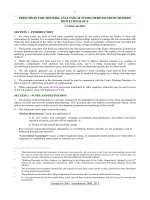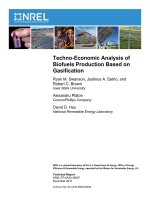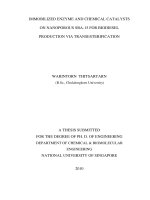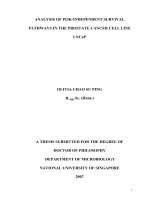Modeling on economic feasibility analysis of biodiesel production from microalgae in china
Bạn đang xem bản rút gọn của tài liệu. Xem và tải ngay bản đầy đủ của tài liệu tại đây (1.5 MB, 84 trang )
MODELING ON ECONOMIC FEASIBILITY
ANALYSIS OF BIODIESEL PRODUCTION FROM
MICROALGAE IN CHINA
JIA ZONGCHAO
NATIONAL UNIVERSITY OF SINGAPORE
2014
MODELING ON ECONOMIC FEASIBILITY
ANALYSIS OF BIODIESEL PRODUCTION FROM
MICROALGAE IN CHINA
JIA ZONGCHAO
(M.Sc., Peking University)
A THESIS SUBMITTED
FOR THE DEGREE OF MASTER OF SCIENCE
DEPARTMENT OF CHEMISTRY
NATIONAL UNIVERSITY OF SINGAPORE
2014
Declaration
I hereby declare that this thesis is my original work and it has been written by me in
its entirety, under the supervision of A/P Stephan Jaenicke, Chemistry Department,
National University of Singapore, between 04/08/2013 and 04/08/2014.
I have duly acknowledged all the sources of information which have been used in the
thesis.
This thesis has also not been submitted for any degree in any university previously.
Name
Signature
I
Date
Acknowledgements
I would like to extend my sincere thanks to my supervisor, Associate Professor
Stephan Jaenicke, who has put great effort into my project during my study in NUS. I
am also very grateful for the many valuable suggestions provided by Associate
Professor Chuah Gaik Khuan.
In addition, I have to thank Miss Toy Xiu Yi, Miss Han Aijuan, Mr. Sun Jiulong,
Mr. Wang Jie, Miss Gao Yanxiu and all the other members of our catalytic research
group, for their sincere assistance and encouragement during this very precious and
memorable one-year stay in Singapore.
In addition, I especially acknowledge the SPORE committee which provided the
scholarship for my study in Peking University and National University of Singapore.
II
Table of Contents
DECLARATION
I
ACKNOWLEDGEMENTS
II
TABLE OF CONTENTS
III
SUMMARY
V
LIST OF TABLES
VI
LIST OF FIGURES
VII
CHAPTER 1 : LITERATURE REVIEW
1
1.1.
1
Introduction
1.1.1.
Background
1
1.1.2.
Biodiesel
3
1.1.3.
Feedstock of biodiesel
4
1.2.
Biological characteristics of microalgae
10
1.3.
Process of microalgal biodiesel production
11
1.3.1.
Technologies for microalgal cultivation
12
1.3.2.
Microalgal harvesting technologies
20
1.3.3.
Dehydration techniques
25
1.3.4.
Lipid extraction
26
1.3.5.
Biodiesel production
31
1.3.6.
Other techniques of producing energy from algae
36
1.3.7.
Other applications of microalgae extracts
40
CHAPTER 2 : MODEL CONSTRUCTION
43
2.1.
System description
43
2.2.
Model description
43
2.2.1.
Cultivation
44
2.2.2.
Harvesting and dewatering
47
2.2.3.
Lipid extraction
48
2.2.4.
Lipid conversion
48
2.2.5.
Co-products production
48
III
CHAPTER 3 : MODEL ANALYSIS
49
3.1.
Mass Balances
49
3.2.
Net energy ratio
49
3.2.1.
Energy estimations for each step
49
3.2.2.
NER calculation
53
Production cost estimation
53
3.3.
3.3.1.
Capital cost
54
3.3.2.
Operating cost
57
3.3.3.
Production cost calculation
57
3.4.
Greenhouse gas emission rate
58
3.5.
Sensitivity analysis
59
3.6.
Conclusion
63
REFERENCES
66
IV
Summary
Although microalgae based biodiesel production has been studied for many
years ever since microalgae have been recognized as the third generation biodiesel
feedstock, there exists still a big gap when considering performing the whole process
at an industrial scale to replace the conventional petroleum-based diesel. Therefore,
this project presents an economic feasibility assessment for a facility that grows algae
and transforms the algal biomass into transportation fuel. In addition to economic
aspects, environmental impact assessment and an analysis of the carbon foot print are
also covered. The whole system takes all the processes from microalgae cultivation to
biodiesel production into account.
The results obtained confirm that with the current technology, microalgal
biodiesel production will not be competitive with the conventional diesel if an
industrial scale facility were to be built today. However, the whole production is
carbon neutral, or even carbon-negative, so that credits for greenhouse gas reduction,
which have not been considered in this study, may impact the economic assessment.
V
List of Tables
TABLES
PAGE
Table 1.1
Common feedstocks for biodiesel production worldwide
5
Table 1.2
Comparison of microalgae with other biodiesel feedstocks
10
Table 2.1
Design specification for PBRs and open pond
45
Table 2.2
Daily seawater consumption for the cultivation process
47
Table 3.1
Model parameters for energy consumed and produced
52
Table 3.2
Fixed parameters for energy consumption calculations
52
Table 3.3
Method and values of the parameters used for the
54
estimation of biodiesel production costs
Table 3.4
Raceway and PBRs capital cost found in literatures
55
Table 3.5
Parameter values for capital cost calculations
56
Table 3.6
Parameters used for the calculation of GHG emission rate
58
Table 3.7
Basic parameters for the three cases.
59
VI
List of Figures
FIGURES
PAGE
Fig. 1.1
World marketed energy consumption, 1990-2040
2
Fig. 1.2
The chemical formula of a triacylglyceride (TAG) and of
3
biodiesel (fatty acid methylester, FAME). R is a long,
linear alkyl with 11 to 21 carbons and possibly one or more
not conjugated double bonds.
Fig. 1.3
General cost breakdown for the biodiesel production
5
Fig. 1.4
A schematic of biofuels production from microalgae
12
Fig. 1.5
View of a raceway pond
15
Fig. 1.6
View of horizontal tubular photobioreactor
16
Fig. 1.7
Transesterification of triacylglycerols and alcohol in the
32
presence of catalysts to yield esters and glycerol
Fig. 2.1
Schematic of microalgal biofuels production process
44
Fig. 3.1
NER of the three cases
60
Fig. 3.2
Required selling price of the biodiesel produced in these
62
three cases in order to achieve a 10% rate of return
Fig. 3.3
GHG emission rate of three cases
VII
63
Chapter 1 : Literature review
1.1. Introduction
1.1.1.
Background
Climate change has been recognized as the perhaps most urgent global
environmental issue today, which requires international collaboration across countries,
sectors and disciplines [1]. As global temperatures increase, all countries will have no
choice but to adapt to limit the human, economic and social impacts of climate
change [1]. It is estimated that if the average global temperature increases by more
than 2 oC, hundreds of millions of people could lose their lives and over one million
species could become extinct [2].
Among the total primary energy consumption of the world, fossil fuel accounts
for 86.7%, while nuclear energy, hydroelectricity and renewable energy account for
about 4.4%, 6.7% and 2.2%, respectively [3]. Considering the current technological
feasibility, potential reserves, and increased exploitation of newer unconventional
resources, such as natural gas and shale oil, it is highly likely that fossil fuels will
continue to be used as the primary energy source at low cost for a considerable period
of time.
However, even if the depletion of fossil energy reserves is not the driving force
towards renewable energy, attention has to be paid to global warming caused by
continuing CO2 emissions. Targeting the problem of the atmospheric greenhouse
gases (GHGs) could be an appropriate stabilization strategy as a starting point for a
global deal [1]. The use of fossil fuels on a large scale and the concomitant emissions
1
of CO2 and other greenhouse gases has caused global warming; therefore, renewable
and environmental-friendly energy sources should be utilized to replace fossil fuels
[4]. Global warming will result in detrimental effects, such as the increase in sea level
and the flooding of lowlands, as well as a transformation of the weather patterns [5].
It is widely accepted that continuing the use of fossil fuels as the major source of
energy is unsustainable because of the environmental issues caused by the carbon
emissions [6].
World energy consumption, 1990-2040
900.0
819.6
Quadrillion Btu
800.0
729.2
700.0
629.8
600.0
523.9
500.0
400.0
354.8
406.0
300.0
200.0
100.0
0.0
1990
2000
2010
2020
2030
2040
Year
Fig. 1.1. World marketed energy consumption, 1990-2040. Source: Energy
Information Administration (EIA).
Fig. 1.1 shows the world energy consumption from 1990 to the present and
projected through 2040. According to the EIA report, over 50% more energy will be
needed in 2040 than today to satisfy the world demand [7]. Clearly, this additional
energy demand cannot be accompanied by a similar increase in carbon dioxide
2
emissions. Accordingly, replacement of fossil fuels with renewable energy should be
advocated and developed in order to tackle these critical issues.
1.1.2.
Biodiesel
Biodiesel, the first alternative biofuel known to the public and the main
alternative to fossil fuels, has received much attention recently. Any diesel-equivalent
biofuel made from renewable feedstocks can be accounted as biodiesel, if it can be
produced through a special process from renewable feedstocks. More specifically,
biodiesel refers to the monoalkyl esters of long-chain fatty acids (
Fig. 1.2) derived by chemical reaction, e.g. transesterification of feedstocks, such
as the vegetable oil or animal fats. Since the vegetable oil is much more viscous than
conventional diesel fuel or biodiesel, it cannot work in the present engines, thus the
plant oil cannot be directly used as fuel.
Fig. 1.2. The chemical formula of a triacylglyceride (TAG) and of biodiesel (fatty
acid methylester, FAME). R is a long, linear alkyl with 11 to 21 carbons and possibly
one or more not conjugated double bonds.
3
Biodiesel is an attractive alternative energy for the following several reasons: (a)
it is a renewable biofuel that can be provided sustainably; (b) it is highly
biodegradable and has hardly any toxicity; (c) it is eco-friendly, resulting in no net
increased release of carbon dioxide, aromatic compounds or other chemical
substances that are detrimental to the environment [6,8,9]; (d) it has a lower
combustion emission profile than the petroleum-based diesel, and there is no
contribution to the global warming due to the closed carbon cycle; (e) its use can
decrease the dependence on imported crude oil, although the calorific value of
biodiesel is less than the fossil fuel; (f) there is little or no need to modify the existing
engines [10] where it can be used with better engine performance; (g) it can be
blended with traditional petroleum-based diesel fuel in any ratio; (h) it can improve
the lubricating properties when added to regular diesel fuel in an amount of 1-2%
[11].
1.1.3.
Feedstock of biodiesel
Because the cost of raw feedstocks accounts for about 75% of the total cost of
biodiesel production (Fig. 1.3), choosing an appropriate feedstock is of vital
importance to lower the biodiesel production cost, and then to make the whole
process of biodiesel production feasible, which means that the biodiesel could
substitute diesel at an industrial scale. The primary biodiesel feedstocks for several
regions of the world are shown in Table 1.1.
4
Energy, 2%
General
overhead, 1%
Direct labour,
3%
Depreciation,
7%
Chemical
feelstocks, 12%
Oil feedstocks,
75%
Fig. 1.3. General cost breakdown for biodiesel production. Source: Ref. [12]
Table 1.1. Common feedstocks for biodiesel production worldwide.
Country
Feedstock
Reference
USA
Soybeans
[13]
Europe
Rapeseed
[13]
Canada
Canola oil
[14]
Africa
Jatropha
[15]
China
Waste cooking oil
[16]
Spain
Linseed oil
[15]
1.1.3.1. First generation biodiesel feedstocks
First generation biodiesel was derived from edible oil feedstock, e.g., rapeseed
[17], soybeans [18,19,20], palm oil [21,22,23,24] and sunflower [17,25,26], etc.
Because more than 95% of the first generation biodiesel was made from edible
5
feedstocks, there was a big impact on the global food market and food security [27].
For instance, soy and rapeseed oil play a vital part in human food. Transforming these
food crops to produce biodiesel on a large scale caused turbulence to the global food
market [28], and consequently, the world encountered a “food versus fuel” crisis
which no one had expected. Moreover, using the crops to produce biodiesel may incur
competition with the edible oil market, which would increase the cost of both the
edible oils and the biodiesel [29].
Producing biodiesel from edible food crops also has a negative impact on the
environment because of the large areas of arable land required to cultivate enough of
this type of feedstock. Therefore, serious ecological imbalances started to become
apparent as countries began cutting down forests to make more land available for the
cultivation of the feedstocks for biodiesel production. Thus, tropical countries such as
Malaysia or Indonesia, which account for about 80% of the world’s palm oil supply,
could face a serious deforestation problem. This could then have a large impact on the
carbon balance because the additional CO2 from decomposing biomass and the
reduced natural CO2 fixation by the forests as well as the long-term carbon storage in
the soil would aggravate the situation of increasing global warming. Large scale
deforestation has already been caused by the expansion of biodiesel production from
food crops. Consequently, biodiesel produced from the first generation biodiesel
feedstocks as a substitute biofuel for petroleum-based diesel fuel could cause
enormous damage to the food market and also the environment around the world.
6
1.1.3.2. Second generation biodiesel feedstocks
Alternative biodiesel feedstocks, such as non-food materials, have been
developed to reduce the dependency on the food crops. The second generation
biodiesel feedstocks include energy crops such as jatropha [25,30,31], tobacco seed
[32], salmon oil [33], waste cooking oil, etc. Biodiesel production from these second
generation biodiesel feedstocks has been widely investigated over the past several
years. The following advantages are the main reasons why these feedstocks are
popular: (a) the “food versus fuel” crisis has been eliminated. Non-edible feedstocks
are not suitable for human consumption owing to the toxic substances in them [34];
(b) they are more eco-friendly and efficient than the first generation biodiesel
feedstocks [35]; (c) they need less farmland to cultivate. Some of the non-edible
feedstocks can be grown in wastelands that are not suitable for food crops [34]; (d)
they can also produce some other useful by-products, which can be used in certain
chemical processes or burned for power and heat, besides of the biodiesel; (e) animal
fat methyl esters have some advantages compared to the first generation biodiesel
feedstocks, such as a higher cetane number and non-corrosive qualities [36].
However, although the second generation biodiesel feedstocks do not compete
with the human food sources and can be grown in wastelands, their production
volume may not be large enough to fulfill the requirement of our total transportation
fuels. Another disadvantage is that biodiesel derived from animal fats has relatively
low performance in cold temperature. Animal fats usually contain a large number of
saturated fatty acids, which makes the transesterification more difficult to proceed
7
[37]. For example, the saturated fatty acids, which account for about 50% of the total
fatty acids in beef tallow, leads to a high melting point and high viscosity in the
biodiesel [38]. In addition, using animal fats to produce biodiesel also presents a
biosafety problem because they might be contaminated [39]. Accordingly, these
second generation biodiesel feedstocks have not been used in biodiesel production at
a significant scale.
1.1.3.3. Third generation biodiesel feedstocks
The most important factor that interferes with the large scale commercial
biodiesel production is the high cultivation cost of the feedstocks [17]. It had been
shown that the first and second generation biodiesel feedstocks are not suitable for a
sustainable energy economy [40]. Although an increasing amount of biodiesel has
been produced from oil crops, its production in large quantities still cannot be
considered as sustainability [41]. However, microalgae, as the third generation
biodiesel feedstock, are a very promising alternative for biodiesel production because
of their higher growth rates and productivity compared to the former biodiesel
feedstocks [42]. Additionally, they are easier to cultivate than many other plants and
can accumulate a higher yield of lipid for biodiesel production.
As is shown in Table 1.2, compared to other biodiesel feedstocks, microalgae
have the highest biomass productivity and oil content. Microalgae with high lipid
content have the potential to produce up to 25 times more biodiesel per unit area than
other biodiesel feedstocks, such as the palm. This very high production efficiency is
8
one reason that microalgae have been considered as a promising material for
biodiesel production. The advantages of using microalgae as a source of biodiesel
production are as follows: (a) reduction in cost and improved efficiencies. Compared
to other biodiesel feedstocks such as non-food crops, the costs regarding to harvesting
and transportation of microalgae are relatively low; (b) microalgae do not compete
for land with food crops used for human food and other products [43], since they can
be cultivated in places that are not suitable for growing other crops, such as brackish,
salt water or non-arable lands [40]. As is shown in Table 1.2, microalgae require less
land to grow compared to other feedstocks. They can also be grown in bioreactors
[39]; (c) the typical oil content of microalgae is in the range of 20 to 50% by weight
of dry biomass, but even higher productivity can be reached [44]; (d) microalgae can
produce valuable co-products such as biopolymers, proteins and carbohydrates, etc.
which could be used as fertilizer or animal food; (e) the photosynthetic efficiency of
microalgae is higher than that of other green plants, which is considered a crucial
advantage of algae to improve the biomass productivity [45]; (f) the lipid profiles in
microalgae are mostly neutral lipids due to their high degree of saturation [46].
9
Table 1.2. Comparison of microalgae with other biodiesel feedstocks.
Feedstock
Oil content (%
oil by wt. in
biomass)
Oil yield
(l oil/ha/year)
Land use
(m2 year/kg
biodiesel)
Corn
44
172
66
152
Soybean
18
636
31
321
Jatropha
28
741
15
656
Rapeseed
41
974
12
862
Sunflower
40
1070
11
946
Palm oil
36
5366
2
4747
Microalgae
(low oil
content)
30
58,700
0.2
51,927
Microalgae
(medium oil
content)
50
97,800
0.1
86,515
Microalgae
(high oil
content)
70
136,900
0.1
121,104
Biodiesel productivity
(kg biodiesel/ha/year)
Source: Ref.[44]
1.2. Biological characteristics of microalgae
Microalgae are primitive plants, which lack roots, stems and leaves, and
chlorophyll a acts as their primary photosynthetic pigment to absorb sunlight for their
growth [47].
As prokaryotic cells, cyanobacteria lack membrane-bound organelles (plastids,
nuclei and mitochondria) and are more similar to bacteria rather than algae. In
contrast, eukaryotic cells, including many different microalgae species, have these
organelles that regulate the normal functions of cells. Eukaryotic algae can be divided
into a variety of classes mainly by their pigmentation, cell structure and life cycle
10
[48]. The following are the most important classes: red algae (Rhodophyta), green
algae (Chlorophyta) and diatoms (Bacillatiophyta).
Algae can be cultivated under either autotrophic or heterotrophic conditions. The
autotrophic cultivation requires sunlight as the energy source, CO2 as the carbon
source, and inorganic salts, while the heterotrophic one requires organic compounds
as the carbon source and the energy source, as well as nutrients. In addition, some
photosynthetic algae are mixotrophic, which means that they can be grown under
either photosynthesis or exogenous organic substances [47].
1.3. Process of microalgal biodiesel production
The whole process from microalgae to biofuels is shown in Fig. 1.4. There are
four main steps of this transformation process, namely cultivation, harvesting,
extraction and conversion. Microalgae can be cultivated in either photobioreactor
systems or open pond systems (e.g. raceway ponds). Then microalgae biomass can be
harvested with either centrifugation or filtration with the assistance of flocculants.
The harvested microalgae biomass will be extracted to obtain the desired lipid and
then be converted to bio-oils with biochemical or thermochemical methods.
11
Fig. 1.4. A schematic of biofuels production from microalgae. At the end of the
transformation route, there are the main products of each process [49].
1.3.1.
Technologies for microalgal cultivation
Phototrophic microalgae absorb sunlight, and assimilate CO2 from the air and
nutrients from the aquatic body to grow under natural environmental conditions. In
contrast, in heterotrophic cultivation conditions, organic substances are utilized as
carbon source (e.g. glucose) instead of CO2 for the growth of the microalgae.
CO2 can be fixed by microalgae from three major different sources: directly
from the atmosphere, from CO2-containing flue gases from industries such as the
power plants, and from soluble carbonates [50]. Most microalgae can tolerate up to
12
150,000 ppmv levels of CO2 [51,52]. Therefore, in the microalgal biomass production
systems, CO2 can be fed into the culture mediums either from external sources such
as flue gases emitted from power plants or as soluble carbonates such as NaHCO3 and
Na2CO3 [53,54].
Besides from sunlight and CO2, inorganic nutrients are required for microalgae
production, primarily nitrogen, phosphorous and silicon [55]. Some microalgae can
fix the nitrogen from the atmosphere [56,57], while most microalgae need it in a
soluble form (e.g. urea) [58]. Phosphorous is another important nutrient, but its
volume requirement is smaller than that for nitrogen during the production cycle [59].
However, because the phosphate ions can bond with metals ions, some excess of
phosphorous must be added over the basic requirement [60]. Silicon plays a crucial
part in the growth of certain microalgae such as diatoms [61].
There are altogether three different production mechanisms of microalgae,
including the photoautotrophic production, heterotrophic production and mixotrophic
production. They will be discussed in the following sections.
1.3.1.1. Photoautotrophic production
Photoautotrophic production is the only way to make the large-scale microalgae
biomass production technically and economically feasible for energy production [61].
In the following chapters, two photoautotrophic microalgae production systems are
described, namely the open pond and closed photobioreactor technologies [62].
13
1.3.1.1.1. Open pond production systems
Open pond production systems have been used for microalgae cultivation since
the 1950s [62]. The most commonly used system are the raceway ponds [63], which
are made of a closed loop, oval shaped recirculation channel (Fig. 1.5) with a depth of
0.2-0.5m. In order to stabilize the microalgae growth and productivity, mixing and
circulation are required during the cultivation. These ponds are usually built in
concrete or from compacted earth lined with white plastic. The culture media and
nutrients are added in front of a paddlewheel, which rotates continuously to prevent
sedimentation during the whole production process. Submerged aerators are installed
to enhance the CO2 concentration in the water [64]. Due to the potential threat from
other algae species and algae-grazing protozoa, open pond systems require highly
selective environments to make the microalgae well-cultivated [65].
Since the open ponds can be installed in marginal areas, there is no competition
with agricultural crops [60] and the cleaning and regular maintenance are easier [66].
However, the biomass productivity of open pond systems is lower than that of closed
photobioreactors [60], mainly because of the evaporation losses, temperature
variation of the medium, inefficient mixing, less light and CO2 deficiencies
[60,66,67].
14
Fig. 1.5. View of a raceway pond. Culture medium is fed into the pond after the
paddlewheel [60].
1.3.1.1.2. Closed photobioreactor systems
Recently, closed photobioreactors (PBRs), which constitute of an array of
straight plastic or glass tubes as shown in Fig. 1.6 [66], have received major research
attention. The tubes can be aligned horizontally [68], vertically [69], inclined [70], or
as a helix [71], and the diameter of them is generally no more than 0.1m [60].
Microalgae cultures can be mixed and circulated either with a mechanical pump or
with an airlift system, which allows the exchange of CO2 and O2 between the medium
and aeration gas [72]. Most closed photobioreactor systems fall into one of the three
categories: flat plate, tubular, and column photobioreactor systems.
15
Fig. 1.6. View of a horizontal tubular photobioreactor [73]. It constitutes of two parts,
the airlift system and the solar receiver. The airlift system regulates the input of CO2
and output of O2 as well as the harvesting of the biomass. The solar receiver are
responsible for the growth of the microalgae, and provide a high surface area to
volume ratio.
One of the earliest forms of closed PBRs systems is the flat-plate PBR [74],
which has received much attention from researchers owing to the large surface area
exposed to illumination [66] and high cells densities (> 80 g/l) observed [75].
Transparent materials are used for maximum sunlight absorption.
The length of tubular PBRs is limited by the potential O2 accumulation, CO2
depletion, and pH change in the systems [72], which results in their finite scale-up.
Large-scale production systems are generally based on the integration of many
reactor units. Because the tubular PBRs systems can expose a larger surface area to
16









